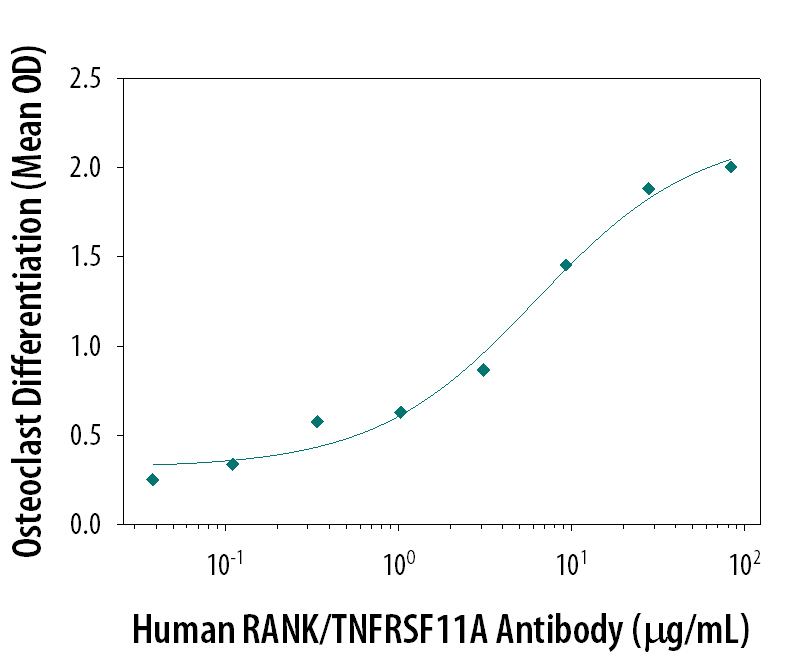Human RANK/TNFRSF11A Antibody Summary
Applications
Please Note: Optimal dilutions should be determined by each laboratory for each application. General Protocols are available in the Technical Information section on our website.
Scientific Data
 View Larger
View Larger
Human RANK/TNFRSF11A Antibody Induces Osteoclast Differentiation in Mouse Splenocytes. Human RANK/TNFRSF11A Antigen Affinity-purified Polyclonal Antibody induces osteoclast differentiation in the presence of 20 ng/mL recombinant mouse M-CSF (Catalog # 416-ML), in a dose-dependent manner, as measured by the tartrate-resistant acid phosphatase (TRAP) solution assay. The ED50 for this effect is typically 4-8 µg/mL.
Reconstitution Calculator
Preparation and Storage
- 12 months from date of receipt, -20 to -70 degreesC as supplied. 1 month, 2 to 8 degreesC under sterile conditions after reconstitution. 6 months, -20 to -70 degreesC under sterile conditions after reconstitution.
Background: RANK/TNFRSF11A
RANK (receptor activator of NF-kappa B, also known as TRANCE receptor, osteoclast differentiation factor receptor [ODFR]) and TNFRSF11A is a member of the tumor necrosis factor receptor family. The full length human RANK cDNA encodes a type I transmembrane protein of 616 amino acids with a predicted 184 amino acid extracellular domain and a 383 amino acid cytoplasmic domain. The extracellular domain contains two potential N-linked glycosylation sites. RANK shares significant amino acid homology with other members of the TNF R family in its extracellular four cysteine-rich repeats. Human and murine RANK share 81% amino acid identity in their extracellular domains. RANK is widely expressed with highest levels in skeletal muscle, thymus, liver, colon, small intestine and adrenal gland. RANK is expressed in dendritic cells. In activated human peripheral blood T lymphocytes, RANK expression is induced by IL-4 and TGF-beta. Multiple tumor necrosis factor receptor-associated factors (TRAFs) are involved in the signaling of RANK. TRANCE (TNF-related activation-induced cytokines, also known as RANK ligand [RANKL], osteoprotegerin ligand [OPGL], and osteoclast differentiation factor [ODF]) is the ligand for RANK. The biological functions mediated through RANK include activation of NF-kappa B and c-jun N-terminal kinase, enhancement of T cell growth and dendritic cell function, induction of osteoclastogenesis, and lymph node organogenesis. Soluble RANK is able to block TRANCE induced biological activity.
- Anderson, D.M. et al. (1997) Nature 390:175.
- Nakagawa, N. et al. (1998) Biochem. Biophys. Res. Commun. 245:382.
Product Datasheets
Citations for Human RANK/TNFRSF11A Antibody
R&D Systems personnel manually curate a database that contains references using R&D Systems products. The data collected includes not only links to publications in PubMed, but also provides information about sample types, species, and experimental conditions.
2
Citations: Showing 1 - 2
Filter your results:
Filter by:
-
Analysis of RANK-c interaction partners identifies TRAF3 as a critical regulator of breast cancer aggressiveness
Authors: Sirinian C, Papanastasiou AD, Karayel O et al.
Neoplasia
-
IL-3 inhibits human osteoclastogenesis and bone resorption through downregulation of c-Fms and diverts the cells to dendritic cell lineage.
Authors: Gupta N, Barhanpurkar AP, Tomar GB
J. Immunol., 2010-07-19;185(4):2261-72.
Species: Human
Sample Types: Whole Cells
Applications: ICC
FAQs
No product specific FAQs exist for this product, however you may
View all Antibody FAQsReviews for Human RANK/TNFRSF11A Antibody
There are currently no reviews for this product. Be the first to review Human RANK/TNFRSF11A Antibody and earn rewards!
Have you used Human RANK/TNFRSF11A Antibody?
Submit a review and receive an Amazon gift card.
$25/€18/£15/$25CAN/¥75 Yuan/¥2500 Yen for a review with an image
$10/€7/£6/$10 CAD/¥70 Yuan/¥1110 Yen for a review without an image


